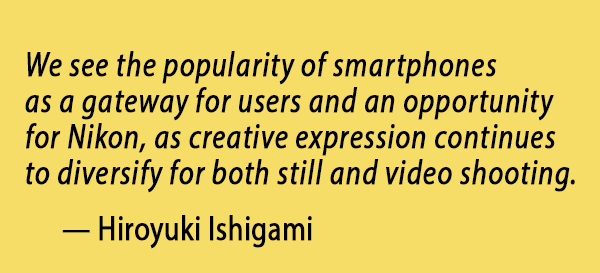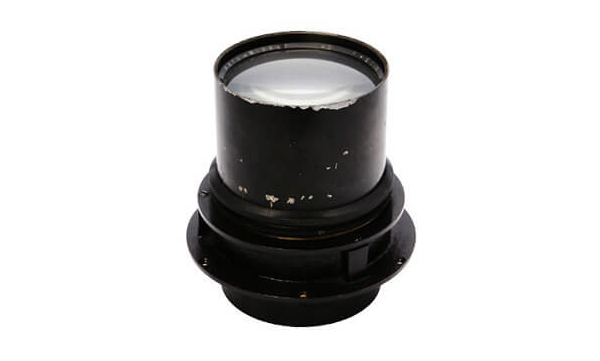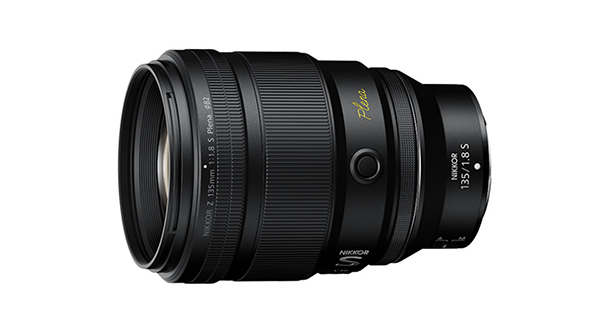In 1932, the trademark NIKKOR was registered by Nippon Kogaku K.K., the legendary Japanese camera manufacturer now known as Nikon.
To commemorate the rich 90-year history of NIKKOR optics, Shutterbug offers you a peek behind the curtain via this interview with three Nikon engineers.

We posed our questions to the three gentlemen pictured above. From left to right, Hiroyuki Ishigami, UX Planning Department, Imaging Business Unit; Akihiko Obama, 3rd Designing Department, Optical Engineering Division; and Satoshi Kazahaya, 2nd Production Department, Optical Engineering Division.
Shutterbug: Can you tell us a bit about yourselves?
(Ishigami) I have been working at Nikon for almost 20 years. I originally studied mechanical engineering and had an interest in photography as a hobby, which led me to join the company with the desire to work on the design of cameras and lenses. During my time here, I became interested in lens product planning, and as a result, I am currently involved in planning activities in the product planning department. My focus in photography is on snapshots. In the past, I enjoyed shooting, developing, and printing black and white film. I still have all the equipment, and I hope to resume that hobby again someday.
(Obama) Since I was young, I have enjoyed taking pictures and observing stars, which led me to major in astrophysics in college. I chose to work at Nikon because I wanted to design lenses that could capture stars as they truly appear. My hobbies include stargazing, traveling, and SCUBA diving. Photography is closely intertwined with these hobbies, and I enjoy capturing astrophotography, snapshots from my travels, and underwater photography. I believe there is always more to learn and improve in photography. Recently, I have been enjoying shooting videos of landscapes from the sky using a drone.
(Kazahaya) I studied mechanical engineering in college because I had a desire to create small, realistic, and precise robots, similar to the size of insects. That’s also why I joined Nikon, a company that excels in precision machinery. I have been in charge of the development and design of interchangeable lenses throughout my approximately 20-year career here. My hobbies include various sports. Sometimes, while exercising outdoors, I enjoy taking close-up shots of insects that I come across. I am always impressed by their delicate, functional, and mysteriously moving small bodies when I magnify and observe them.
SB: Which Nikon lenses are your personal favorites?
(Obama) My favorite lens is the AF-S 14-24mm f/2.8 G. It is a classic lens for astrophotography and has been very useful in capturing stars as they truly appear, although it is not one of my own designs. I also love wide-angle lenses, so I have used it extensively for snap and landscape photography. However, recently, I have been shooting more with mirrorless cameras, and I find myself using the Z 14-30mm f/4 S lens more often. Both lenses provide a dynamic perspective and deliver reliable results with stable performance. They are my beloved lenses.
(Kazahaya) One of my favorites is the Z 70-200mm f/2.8 S. It has fast and comfortable autofocus, allowing me to capture fast-moving subjects accurately even during high-speed continuous shooting. The lens delivers outstanding image quality. I also like its moderate size, which gives a cool appearance during use. It’s also compatible with teleconverters, allowing me to achieve significantly higher magnification without changing the overall size and making shooting with it even more fun!
(Ishigami) It’s difficult to choose just one favorite lens because there are so many, but I have a strong attachment to the lenses I have been involved in planning. However, if I were to choose, it would be the AF-S NIKKOR 105mm f/1.4E ED and the NIKKOR Z 58mm f/0.95 S Noct. The 105mm f/1.4 was a lens where we had many discussions among the team members during the early planning stages to determine the direction we should take with it in terms of image rendering. It was a product that we achieved through a different approach than usual, and it received significant recognition even after its release. The Noct is another important lens to me. There were many challenges in giving the lens a unique name, as well as creating a manual focus lens in this day and age. Ultimately, we were able to achieve specifications and performance that fully utilize the benefits of the Z mount, making it a symbolic lens for the Z mount system.

In 2018, Nikon leveraged their accumulated knowledge and expertise to launch the Z mount system. Pictured here is the Nikon Z7.
SB: Disregarding computer-assisted optical design, what has been the most significant breakthrough in lens design since the introduction of the original F mount?
(Obama) The most significant breakthrough in lens design since the introduction of the original F mount is the birth of the Nikon Z mount system. In 2018, we gathered the knowledge and expertise we accumulated over the years to announce the Nikon Z mount system, which consists of mirrorless cameras that feature the industry’s largest diameter mount, along with NIKKOR Z lenses and accessories. Leveraging the combination of the Z mount and its large diameter of 55mm and a short flange focal distance of 16mm, NIKKOR Z lenses continue to pursue a new dimension of optical performance by utilizing the increased freedom in design it provides.
With the adoption of the Z mount, the definition of the mount has changed, leading to a change in design conditions. In other words, the increase in aperture diameter and the shorter flange focal distance have expanded the possibilities in optical design.
Moreover, the adoption of the Z mount enables high-speed communication between the camera body and the lens, allowing real-time and precise image processing correction, such as distortion compensation, as well as high-precision and high-speed AF control. This has enabled optical and mechanical designs that are optimized for optical design in coordination with image processing and AF control.
SB: What role could AI play in optical design in the future?
(Obama) That’s an interesting question. We are now in an era where AI is impacting our lives and work in various fields. Undoubtedly, AI will also have an influence on optical design methodologies. Optical design is a continuous process of exploring design solutions that meet the desired specifications and performance. Previously, solutions were chiefly sought through physical and optical considerations, but with the advancement of AI, it may replace some of those processes. However, I cannot provide specific details at this time.
SB: Mid-quality performance of smartphones has lowered consumers’ expectations of image quality. Does the growing acceptance of cellphone-quality images as “good enough” threaten the traditional photo industry?
(Ishigami) We see the popularity of smartphones as a gateway for users and an opportunity for Nikon, as creative expression continues to diversify for both still and video shooting. This is especially true amongst younger audiences. The need for better imaging is expanding and becoming more apparent. People are also sharing more photos than ever before, and image quality and camera capability is what sets apart a lot of content. High-definition images with an eye-opening, three-dimensional feel can only be captured with the proper tools. We aim to leverage this interest and consider the target audience of each product to effectively communicate the unique benefits that Nikon gear can provide users.

SB: Are there specific challenges or opportunities in adapting lenses for emerging imaging technologies including VR, AR and/or AI?
(Obama) The adaptation of lenses for emerging imaging technologies such as VR, AR, and AI presents specific challenges and opportunities. The lens specifications required for these use cases may vary depending on the specific application. It is important to define and accommodate functions and qualities that are highly compatible with these technologies, in addition to traditional evaluation metrics such as MTF.
Regarding AI, its application depends on the specific use case. When using AI for image correction, the issue of authenticity always arises as a challenge. On the other hand, AI greatly contributes to improving AF performance in areas such as face detection and eye detection. The continued advancement of AI technologies will continue to improve AF performance, as it extends into object detection to include animals and vehicles, in addition to humans, as well as with improvements in detection accuracy. In the future, we aim to continue technological development to enable creators to concentrate even more on composition and timing.

My personal favorite legacy NIKKOR. Introduced in 1963, the Micro-NIKKOR Auto 55mm f/3.5 that I purchased secondhand about 30 years ago still produces amazing images.
SB: As a journalist who writes about the photo industry, what should I give special attention to when I review camera lenses?
(Ishigami) At Nikon, in the planning and development of lenses, we carefully consider the balance of functionality and performance to create optimal lenses, taking into account various use cases and target audiences. A point I would love to see further considered in lens reviews is the overall balance of the lens. Additionally, while factors such as usability, durability, and weather resistance may not receive much attention in evaluations, Nikon pays attention to the materials and arrangement of components. It would be great if not only the image quality but also these aspects that we find so important are clearer to customers.
(Kazahaya) Another point that NIKKOR Z lenses excel in generally, is AF performance, particularly in terms of focus accuracy, AF speed, and quietness. This is a perspective I would consider when reviewing lenses.
However, AF performance may be affected not only by the characteristics of the lens, but also by the settings of the camera body and the conditions of the subject, so it requires a comprehensive review, taking into account the conditions and environment at the time of shooting.
(Obama) Another point that we hope is evaluated in reviews is whether the characteristics of the product demonstrated by the manufacturer are delivered in a way that meets the expectations of the users that the manufacturer is targeting. For example, when emphasizing “fast and silent AF drive,” does it truly deliver that benefit? Is it a product that the user would want and appreciate? These are questions that should be evaluated, in my opinion. The goal is to provide users guidance in determining whether they can trust what the manufacturer claims when choosing a product.
In terms of image performance, I feel that we have entered an era where the individual characteristics of lenses are more sought after than evaluations based on absolute optical performance indicators. Rather than evaluating the “height” of optical performance, evaluating the “characteristics” of image performance would be helpful for users in finding lenses that align with their preferences.
SB: Can we expect to see more retro-styled lenses similar to the 28mm f2.8 SE for the Nikon Z fc and/or full-frame mirrorless Nikons?
(Ishigami) Since the release of the Z fc, we have received numerous requests for more heritage style lenses, and we recognize the demand for them. While we cannot provide specific details about new products, we will consider these requests while listening to the voice of the market.

The optic that started it all, the 1933 Aero-Nikkor.
SB: Are there ongoing efforts to make camera lenses more environmentally friendly in terms of materials and manufacturing processes?
(Ishigami) Nikon actively promotes the reduction of greenhouse gas emissions, in order to achieve carbon neutrality. Goals have been set forth for up to the fiscal year 2030 regarding these efforts. Further, we are working to introduce energy-saving measures and renewable energy sources. In particular, for lenses, Nikon utilizes quality engineering methods to reduce the number of experimental trials in glass manufacturing through simulation, thereby reducing GHG emissions and waste generation.
Nikon believes that there is more that can be done in lens development and manufacturing, and will continue to explore and consider further measures in the future.

SB: How do optical engineers address accessibility concerns in lens design for a diverse range of users, including those with special needs due to handicap or vision problems?
(Kazahaya) As a whole, Nikon has always placed focus on ergonomics in design, not only in terms of appearance but also in the shape of the controls, making it clear to touch which operation ring is which. Additionally, considering that people have varying levels of strength, we design products to be durable and lightweight, aiming for easy handling and usability. We also consider safety in the shape of the product. We will continue to refine these aspects in our ongoing efforts.
(Obama) Looking back at history: for example, focusing. We have been developing camera systems that do not rely on visual acuity, starting from the era when focusing relied on eyesight or split-image focusing. Through the efforts of AF development, optical designers have been deeply involved in the technological advancements of AF modules and phase-detection AF sensors.
Moreover, by providing camera viewfinders instead of relying solely on rear LCD screens, which may be difficult to see for those with presbyopia [farsightedness] like myself, we have improved accessibility for framing and setting visibility by allowing adjustments to the viewfinder’s visual acuity and brightness according to the user’s visual acuity. In the design of viewfinder optical systems, we have pursued ease of viewing and clarity. These efforts have been beneficial for individuals with or without special needs.
However, there is still room for improvement in terms of customization to address specific needs, and I believe there are things that can be done as engineers to improve accessibility. I would like to continue designing and working on the entire camera system, not just optics, with a focus on enhancing accessibility.

The Nikon NIKKOR Z 135mm f/1.8 S Plena lens was launched in 2023.
SB: What innovations can Nikon fans expect to see in the near future?
(Obama) Until now, the emphasis has been on the high optical performance of lenses, such as excellent resolution. In the future, we will place a greater emphasis on the concept of “lens personality” and strive to provide a diverse range of lenses that cater to our customers’ preferences.
(Kazahaya) We aim to develop technology that can capture fast-moving and irregular subjects with even greater clarity. We are continuously evolving various key technologies, such as further improving the speed and precision of autofocus and enhancing image stabilization effects, to achieve a more comfortable shooting experience for our customers.
Acknowledgement
Special thanks to the folks at Nikon, the public relations professionals at MWW (MikeWorldWide) and especially account executive Valentina Marmolejo for their extensive help making this interview possible.
—Jon Sienkiewicz













